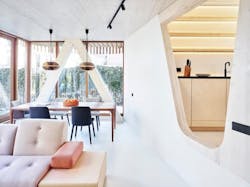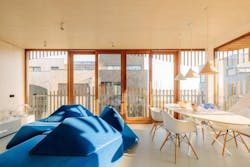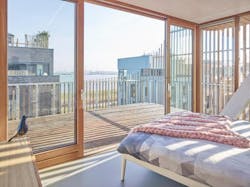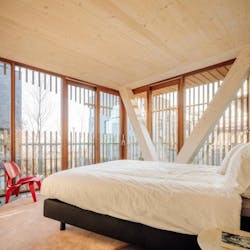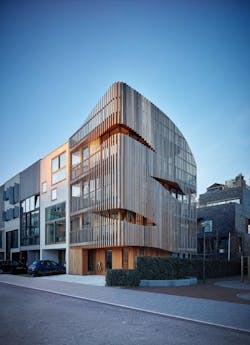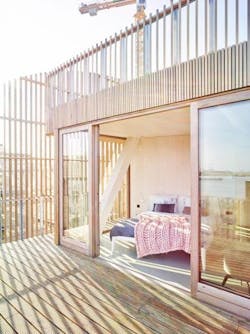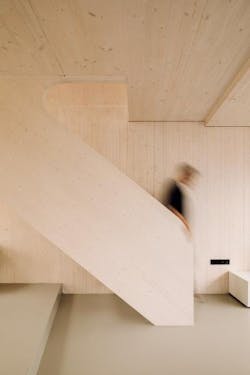Project of the Week: An Amsterdam Duplex Created With Biophilic Living in Mind
Designed and developed by Amsterdam, Netherlands-based studio GG-loop, the Freebooter is a two-family duplex apartment building that balances environmental construction with the wellbeing of its inhabitants.
“We are part of nature in a deep and fundamental way, but in our modern lives we’ve lost that connection,” says Giacomo Garziano, architect, designer, and
founder of GG-loop. “Our studio envisions home and city design that respects both inhabitants and the environment, reconnecting both in the process.”
[ Read More: PROJECT OF THE WEEK: AN URBAN HOME WITH A WILD DRAGON-SCALE METAL ROOF ]
Freebooter is a small building consisting of two duplexes measuring 1,292 square feet each. Located in the center of the island of Zeeburgereiland in Amsterdam and facing the Ij river, the building is sensitive to Dutch history, customs and culture. In fact, maritime design was the main source of Freebooter’s aesthetic and was also a source of technical inspiration.
The project also takes cues from Dutch maritime history, and in particular to Freebooters’, historical figures who assembled freelance sailing teams to take to the high seas in search of adventure and new lands, the company says. Freebooter’s design was inspired by their courageous spirit, as it explores new realms of design.
“The Dutch have always been pioneers and innovators, and have an incredible drive to go for it,” Garziano says. “So too did the team that built these homes.”
[ Read More: PROJECT OF THE WEEK: REPURPOSED SHIPPING CONTAINERS USED TO CREATE PREFAB UNITS ]
GG-loop’s design aesthetic is extravagant without being invasive. The architects made it visionary and futuristic while paying attention to local cultures, customs, and sensibilities. The building was entirely prefabricated down to the last detail, with western red cedar, pine, and steel being the key materials used throughout each apartment, references to the materials used in ship-building. Each apartment’s floor plan references a ship’s layout—organic and free-flowing, with step-inclines to spaces that are designed to envelop and unfold as the inhabitant moves through the unit.
One of the most important features of Freebooter is its use of light. Garziano studied the movement of the sun year-round to create the parametric shape and positioning of the building’s louvers, allowing optimal sunlight to flood the apartment while at the same time maintaining privacy of the inhabitants.
[ Read More: PROJECT OF THE WEEK: A NEW YORK CONDO BUILDING WITH HOTEL-LIKE FEATURES ]
The floorplan, flow of spaces, and organic lines were also created with careful consideration to daily use and the typical tasks of dwellers. As a result, the home is a healthy and productive habitat for rest and living. “The spaces are very fluid and organic, and unfold as you move through the home,” Garziano says.
Freebooter is made of a hybrid structure of Cross Laminated Timber (CLT) and steel, and was prefabricated offsite, allowing for an exceptionally fast built-time of three weeks for the four floors. Finishing the block took six months.
“In the initial studies, comparative tests were made between a concrete structure and the CLT structure,” the company says. “The latter has proven to be the most qualitative solution, thanks to its structural performance and its optimization of construction time, but also its carbon footprint since wood naturally stores CO2. The impact on the cost of an efficient CLT structure is less than 10%, compared to a concrete solution.”
[ Read More: PROJECT OF THE WEEK: A CHICAGO HOUSE THAT REINTERPRETS TRADITIONAL ARCHITECTURE ]
The building's energy consumption is close to zero, thanks to a combination of 24 solar panels on the roof, high-performance wall insulation, and glass walls, coupled with low-temperature in-floor heating and a mechanical and natural ventilation system. Up to 98% of the wood used in the project has been certified by Programme for the Endorsement of Forest Certification, and with 122.5 m3 of wood used, the building stores nearly 80 tons of CO2, offsetting nearly 434,959 miles of exhaust gas from a mid-range car and the energy consumption of 87 homes in one year.
“Celebrating craftsmanship in contemporary design, this building of two tailor-made apartments harmonizes form and function on a meticulously designed plan,” the company says. “With a striking exterior, it has become a central point of the district; the block opens onto a compact interior plan revealing combinations of windows, wooden interiors, and high-quality finishes, with open organic curves that walk through comfortable living spaces, promoting a feeling of well-being and connection to nature.”
[ Read More: PROJECT OF THE WEEK: A DESIGNER USES CHARRED WOOD SIDING FOR A HOME EXPANSION ]
